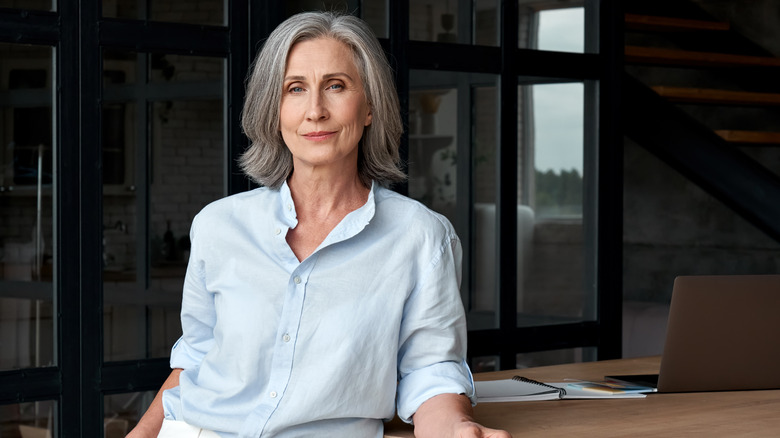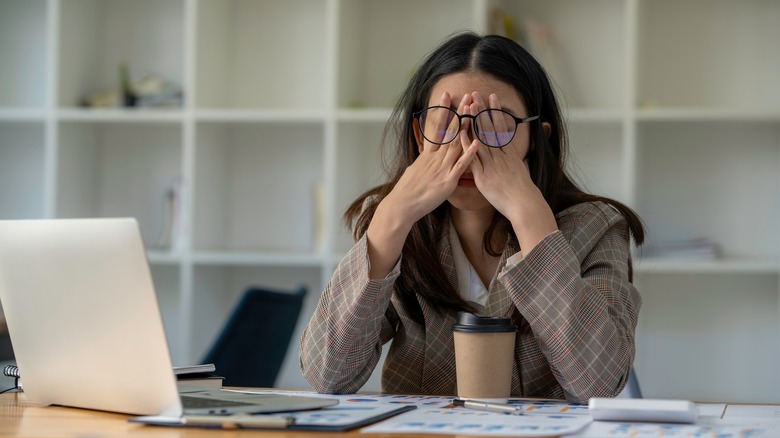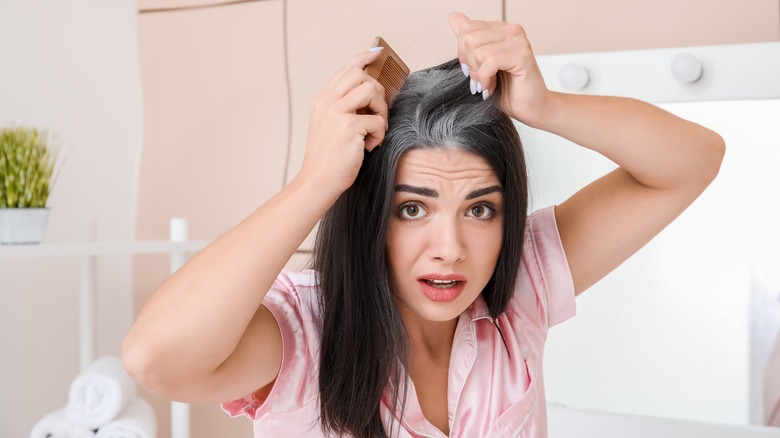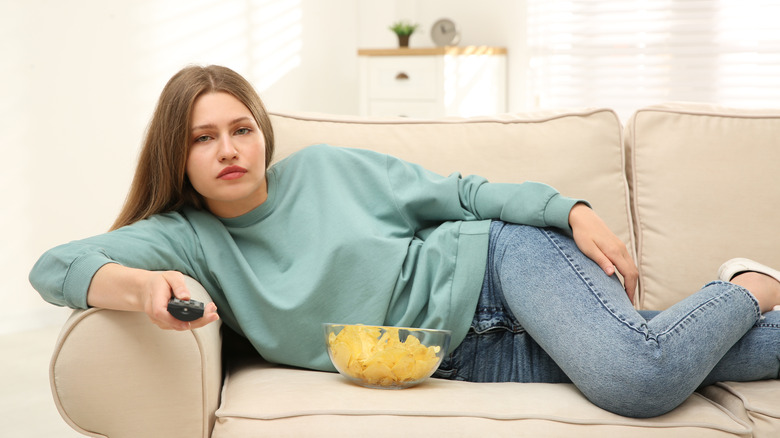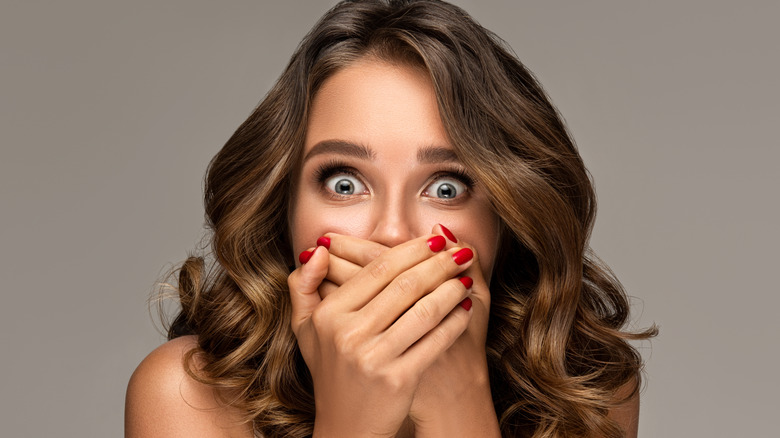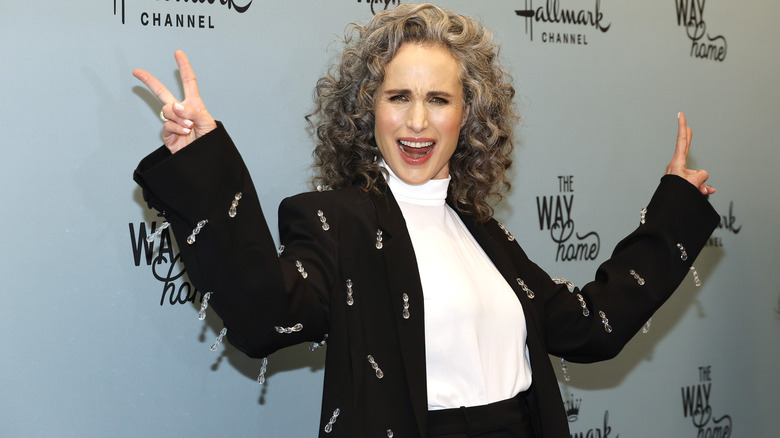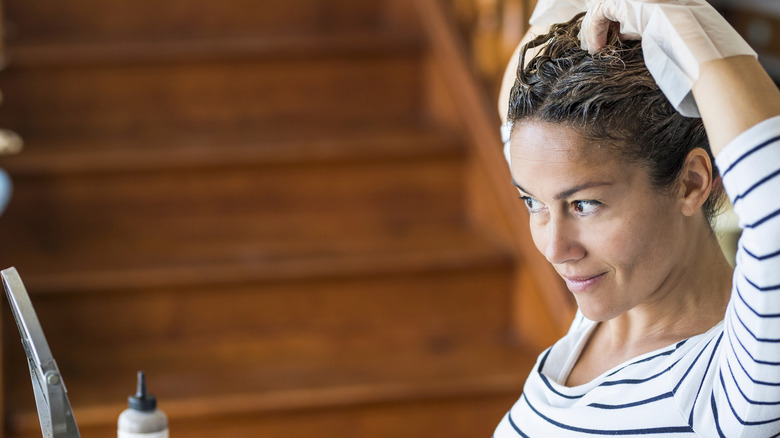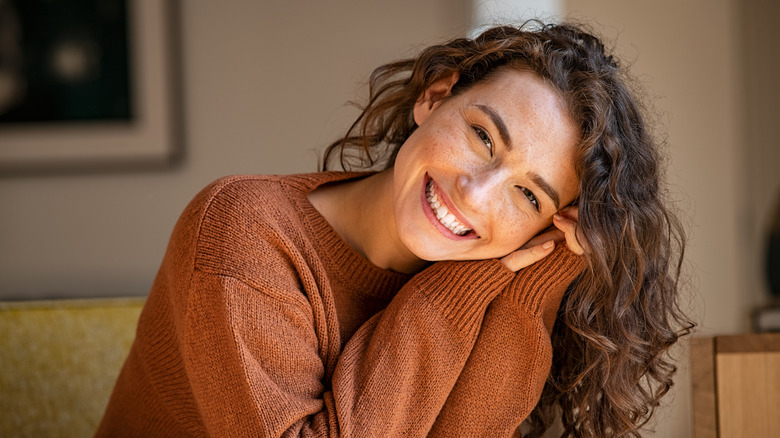What Really Happens When Your Hair Goes Gray
You've spotted it: your first gray. You might have been shocked, scared, or immediately gone through the five stages of grief for your youth when you saw it. In other words, finding gray hair isn't fun. That doesn't mean you should panic, though, partly because stressing may contribute to going gray but also because some gray hair may not be as big of a deal as you think.
Even though finding new grays can be an unnerving experience, it's not a lonely one. Most of us will experience at least some graying by our 30s. If it's premature graying that you're concerned about, you're not alone with that, either, as plenty of people are discovering silver strands in their manes as early as their 20s.
If knowing that you are not alone doesn't make you feel better, then maybe you can take some solace in the fact that there are many things you can do to help slow down or even prevent gray hair from developing. Not only that but, for some, graying may even be reversible. If you want to know what is really happening when your hair goes gray so you can take better control of your hair health, here are some things to keep in mind.
Why does hair go gray?
When your hair turns gray, it isn't actually gray. It's really just a clear strand of hair with no pigment or melanin. In the womb, hair is colorless until melanin begins to form before you are born. Melanin, which also gives skin its color, produces melanocyte cells within the hair shaft. These cells exist within the hair follicle and determine the color of that hair strand, whether it is black, brown, red, or blond. More melanin means a deeper color. For example, black or dark brown hair has more melanin than pale red or blonde hair. Melanin also naturally decreases as we age, due to the buildup of hydrogen peroxide within the hair follicle. Hydrogen peroxide prevents the formation of melanin, which is why gray hair is a common sign of aging.
However, natural aging is not the only thing that can cause hair to go gray. Damage to hair follicles, lifestyle factors like smoking and activity levels, as well as medical conditions, are all things that can contribute to graying.
Your genes play a big role
Genetics is not the only thing that plays a role in going gray, but they do matter. Genetics may have more to do with when your hair goes gray than any other factor. This is especially true regarding premature graying, which some define as going gray in your 20s or earlier. If you want to get specific, it's the IFR4 gene that influences when your hair goes gray. The IFR4 gene is important because it influences the TYR gene, which affects enzymes needed for melanin production.
That said, you do not need to understand the science behind hair-related genetics to know when you might start seeing your first grays. If one or both of your parents went gray early, chances are you might, too. So, if you want to know when you will go gray, ask your parents when it happened to them or flip through some old family photos.
Diet and nutrition make a difference
Poor nutrition can also impact when your hair turns gray. Hair needs a wide range of nutrients to grow properly, so it's no surprise that poor nutrition could lead to gray hair. Some nutrients impact hair color more than others, like vitamins B12 and D. Additionally, those with a deficiency in B12 are more likely to have deficiencies in their other B vitamins that impact hair health, like biotin and folate. Vitamin D, the sunshine vitamin, plays a role in melanin production in the hair follicle. But hair health isn't just about vitamins.
Protein is essential for healthy hair growth. Also, minerals like copper and zinc can have a lot to do with maintaining color in your hair. Catalase can also factor in since it breaks down hydrogen peroxide, which hinders melanin from synthesizing into water and oxygen. If you are worried about not getting enough nutrients in your diet, adding a supplement may help. That said, nutrients may be more easily absorbed and used by your body when obtained through your diet.
Lean meats are high in B12, while vitamin D is found in fatty fish and eggs. Going outside and soaking up some sun can also be effective for upping D levels. Copper can be found in nuts, seeds, spirulina, and shiitake mushrooms, while zinc is frequently found in oysters, lamb, and beans, and catalase is bountiful in foods like onion and pineapple.
Oxidative stress can have an impact
Oxidative stress occurs when there are too many free radicals in the body and too few antioxidants to combat them. A free radical is an unstable atom that damages cells and can ultimately lead to aging and disease. This also means they can lead to more gray hairs popping out of your head. Free radicals cannot be completely avoided because your body naturally produces them, but there are outside factors that influence the number of free radicals you have within your body. Exposure to pollutants, hazardous chemicals, smoking, fried foods, and alcohol can all lead to more free radicals.
One way to keep free radicals in check is to limit your exposure to things that create free radicals, another is to up your intake of antioxidants. Antioxidants are molecules that can help prevent the oxidation of other molecules. Vitamins C and E, and foods that contain these vitamins, are high in antioxidants. Some of these include fruits like oranges, lemons, raspberries, and strawberries. If you're not big on eating fruit, green and especially white teas are also antioxidant powerhouses that have myriad health benefits, so why not grab a cuppa?
Stress can steal your color
It isn't just oxidative stress that you need to think about when it comes to gray hair. Daily stressors can contribute to going gray, too. Anything that can cause your body to kick into flight or fight mode might harm your hair color. This is due in part to the fact that stress can reduce the number of melanocytes in your hair follicle. Although these melanocytes diminish gradually as we age, stress can speed up the process.
You need to keep in mind, though, that stress comes in many different forms. It isn't just the oh-no-I'm-running-late-to-work-again kind of stress that can wreak havoc on hair. Major emotional trauma like a breakup, losing a job, or any other type of significant loss or change can be highly stressful and can cause problems for your hair health as a result.
That said, don't stress out about your stress levels. In many cases, it's not possible to eliminate stress from your life, but that doesn't mean you are doomed to look like a grandma before your time. While you may not be able to prevent stressful events from occurring, there are steps you can take to manage your stress levels in general. Going on long and relaxing walks, practicing yoga, or simply carving time out for a favorite hobby can be great ways to help kick stress to the curb.
Your lifestyle can lead to going gray
Your lifestyle can influence when you go gray and how many grays you will see. Anything that can impact your overall health may also affect your hair color. This means that habits like smoking, being a couch potato, bingeing on junk foods, and too many nights of heavy drinking could encourage a new crop of grays to form.
Of all the lifestyle factors, smoking may be one of the worst ones for maintaining healthy and vibrant hair. Studies have shown that smokers go gray an average of three years before non-smokers do. This may be due partially to the fact that smoking depletes your body of vitamins and minerals essential for hair health. Not only that, but it puts a lot of stress on your body, and increases oxidation levels.
Inactivity may be another factor in seeing more gray hair. A study was done on mice that showed that the more active rodents had noticeably less gray fur. Even though the study was done on mice, it can still shine some light on how graying and activity levels may be linked in humans.
Your ethnicity factors in
Your ethnicity can have a lot to do with when you see your first smattering of gray hair, or if you really go gray at all. White people tend to go gray the earliest, with first grays appearing in their mid-30s on average. The average age at which Asian folks see their first grays is in their late 30s, while the average is in the 40s for Black individuals.
It's been said that for the general population, 50% of people will be 50% gray by age 50. However, recent studies have suggested that the range falls between 6% and 23%. Of the general population, white people tend to see more graying overall. Asian and Black individuals, on the other hand, see less overall gray hair and may not see much gray at all, even at an advanced age.
Along with the number of grays you are likely to see, your ethnicity can also impact the type of damage most likely to occur to your hair. Asian individuals and white people see more damage at the ends of their hair, while Black individuals see damage closer to the root.
Medical issues can mean more grays
Even though a medical issue may not necessarily be the most common reason for more grays popping up in your hairline, there are medical problems that can lead to more gray locks. Common culprits behind increased graying are thyroid and pituitary diseases.
A deficiency in vitamin B12 can also mean more grays, as can vitiligo, a condition that kills pigment-making cells in your skin and scalp. Autoimmune disorders that cause hair thinning or damage to the scalp may lead to gray hair, too. Also, some medications can cause gray hair, so even if it isn't the medical condition leading to grays, the medication you take for it could be to blame.
Because of this, if your hair is turning gray quickly, it may be a good idea to check in with your doctor. While it may very likely be nothing at all, the sudden appearance of gray hair could indicate that something needs to be checked out.
What about your hair down there?
If you notice gray hair on your head, you may start to wonder what will happen to your other hair elsewhere. While you probably will see a few grays in your pubic zone eventually, it is not likely to start just because you have a few grays on your head. Pubic hair can take much longer to go gray, and for some, it may not go gray at all. The same goes for other body hair, like arm and leg hair. These hairs tend to go gray much more slowly and could possibly retain their color indefinitely.
Your facial hair, though, is another matter. Eyebrows are prone to going gray, and they will go gray for the same reasons that the hair on your head does. However, they tend to lose pigment more slowly, and you aren't likely to see your eyebrows start graying before your hair. Gray eyelashes are another thing to look out for, even though they may not show up until long after you notice grays on your head. Still, many people dye their hair and eyelashes gray to be trendy, so don't sweat it if gray hairs appear. It means you're cool!
Gray is just a color
Even though seeing some new white hairs sticking up can seem like a cause for panic, it doesn't mean that you will turn into a full-blown Golden Girl overnight (not that it would be a bad thing since they never let gray hair stop them from having a good time). Going gray can be a very gradual process, and besides that, the culture of covering up grays is starting to fade away. Celebrities like Andie MacDowell and Sarah Jessica Parker are ditching the dye and letting their gray locks glow on the red carpet.
Gray is just a color and having some gray hair does not define you as a person. It also doesn't mean that you are old or look old. Going gray is just something that occurs naturally over time that most of us will have to deal with at some point or another, so why not embrace it? (And who said being old was a bad thing, anyway?)
Another thing to remember is that even though gray hair can be connected to some health issues, it is not necessarily a harbinger of bad health. Some studies have shown no discernable connection between gray hair, wrinkles, and heart health, which means that even if you're sporting a few more silver strands than usual, it doesn't necessarily mean you're aging prematurely.
Ways to cover up your grays
Of course, just because celebrities are making gray look glam doesn't mean that everyone is comfortable letting their grays show. Most of us know we can color grays with dye, but that doesn't mean dyeing your hair is your only option. While it can be convenient and effective, plenty of natural and less permanent options are available to those that do not want to commit to dyeing their hair regularly or are bothered by the chemicals in the dye.
Besides permanent and temporary dyes, hair powders and tinted dry shampoo can provide temporary coverage of grays. Hair powder can be applied with a small brush and washed out later. It is most effective for those that only want to cover up a small area, like streaks at your temples or the roots of your part. Tinted dry shampoo can be used the same way as a regular dry shampoo.
If you want to go the purely natural route, there is no shortage of options to help cover your grays or even potentially help reverse them. Henna and indigo are natural alternatives to traditional dyes that are less harsh on hair. It should be noted that dyeing hair with henna on it could lead to discoloration (green if you bleach your hair). Coconut oil, alma seed oil, and onion juice rinses are natural options that some use for gray coverage and are great for scalp and overall hair health too.
Good news, graying may be reversible
If you're worrying about gray hairs, here is one good reason to stop: gray hair may be reversible. Although it is not necessarily reversible in all cases, there is some evidence that hair that has gone gray due to stress can be returned to its natural color once the stressor has been removed and you have taken steps to actively relax. If you don't meditate already, this could be a good reason to pop into lotus pose and try it out.
Along with managing stress, some supplements may give your hair a healthy boost and help restore color. Fo-ti, for example, has helped some bring new color back into their strands and could be worth trying even if most of its backing is anecdotal and not scientific. Others may be able to reverse grays by addressing nutrient deficiencies. However, if you truly want to take action against growing gray, the best thing you can do is focus on prevention. A healthy, active lifestyle with a nutrient-dense diet can be a great way to start keeping the grays at bay. Ultimately, whether you intend to cover them up or let them glow, understanding how and why hair goes gray can help you look at your hair in a whole new light and feel more empowered about what you choose to do with it.

